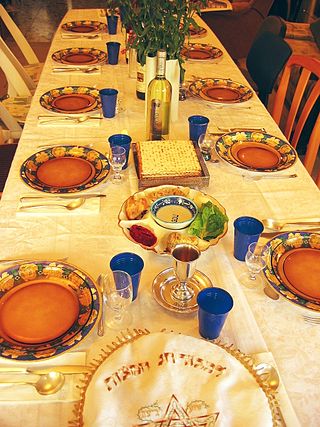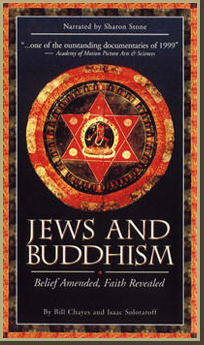
The Passover Seder is a ritual feast at the beginning of the Jewish holiday of Passover. It is conducted throughout the world on the eve of the 15th day of Nisan in the Hebrew calendar. The day falls in late March or in April of the Gregorian calendar. Passover lasts for seven days in Israel and, among most customs, eight days in the Jewish diaspora. Where seven days of Passover are observed, a seder is held on the first night; where eight days are observed, seders are often held on the first two nights, the 15th and 16th of Nisan. The Seder is a ritual involving a retelling of the story of the liberation of the Israelites from slavery in ancient Egypt, taken from the Book of Exodus in the Torah. The Seder itself is based on the Biblical verse commanding Jews to retell the story of the Exodus from Egypt: "You shall tell your child on that day, saying, 'It is because of what the LORD did for me when I came out of Egypt.'" At the seder, Jews read the text of the Haggadah, an ancient Tannaitic work. The Haggadah contains the narrative of the Israelite exodus from Egypt, special blessings and rituals, Talmudic commentaries, and Passover songs.

Meshullam Zalman Schachter-Shalomi, commonly called "Reb Zalman", was one of the founders of the Jewish Renewal movement and an innovator in ecumenical dialogue.

Hayim Nahman Bialik was a Jewish poet who wrote primarily in Hebrew and Yiddish. Bialik is considered a pioneer of modern Hebrew poetry, part of the vanguard of Jewish thinkers who gave voice to a new spirit of his time, and recognized today as Israel's national poet. Being a noted essayist and story-teller, Bialik also translated major works from European languages.

Dunash ha-Levi ben Labrat was a medieval Jewish commentator, poet, and grammarian of the Golden age of Jewish culture in Spain. He is known for his philological commentary, Teshuvot Dunash, and for his liturgical poems D'ror Yiqra and D'vai Haser.
David Lehman is an American poet, non-fiction writer, and literary critic, and the founder and series editor for The Best American Poetry. He was a writer and freelance journalist for fifteen years, writing for such publications as Newsweek, The Wall Street Journal, and The New York Times. In 2006, Lehman served as Editor for the new Oxford Book of American Poetry. He taught and was the Poetry Coordinator at The New School in New York City until May 2018.
A Jewish Buddhist is a person with a Jewish background who believes in the tenets of a form of Buddhism.
Samuel ibn Naghrillah, mainly known as Samuel the Prince and Isma’il ibn Naghrilla, was a medieval Sephardic Jewish Talmudic scholar, grammarian, philologist, soldier, merchant, politician, and an influential poet who lived in Iberia at the time of the Moorish rule. He held the position of Prime Minister of the Taifa of Granada and served as the battlefield commander of the Granadan army, making him arguably the most politically influential Jew in Islamic Spain.

Hebrew literature consists of ancient, medieval, and modern writings in the Hebrew language. It is one of the primary forms of Jewish literature, though there have been cases of literature written in Hebrew by non-Jews. Hebrew literature was produced in many different parts of the world throughout the medieval and modern eras, while contemporary Hebrew literature is largely Israeli literature. In 1966, Agnon won the Nobel Prize for Literature for novels and short stories that employ a unique blend of biblical, Talmudic and modern Hebrew, making him the first Hebrew writer to receive this award.
Stuart Ross is a Canadian fiction writer, poet, editor, and creative-writing instructor.

The Jew in the Lotus is a 1994 book by Rodger Kamenetz about a historic dialogue between rabbis and the Dalai Lama, the first recorded major dialogue between experts in Judaism and Buddhism. The book was a popular success and became an international best-seller. Writing in The New York Times, Verlyn Klinkenborg cited its broader relevance as a book "about the survival of esoteric traditions in a world bent on destroying them." The book was primarily potent in capturing an ongoing engagement in the US between Jews, often highly secularized, and Buddhist teachings. Kamenetz popularized the term JUBU or Jewish Buddhist, interviewing poet Allen Ginsberg, vipassana teacher Joseph Goldstein, Ram Dass and other American Jews involved with bringing Eastern traditions to the West. The book also made prominent a Jewish mystical response to Eastern spirituality in the Jewish renewal movement, led by Rabbi Zalman Schachter-Shalomi, and Jewish meditation as taught by Rabbi Jonathan Omer-Man. The title is a pun on the Vajrayana mantra Om mani padme hum which is frequently interpreted as "hail to the jewel in the lotus".

Zoketsu Norman Fischer is an American poet, writer, and Soto Zen priest, teaching and practicing in the lineage of Shunryu Suzuki. He is a Dharma heir of Sojun Mel Weitsman, from whom he received Dharma transmission in 1988. Fischer served as co-abbot of the San Francisco Zen Center from 1995–2000, after which he founded the Everyday Zen Foundation in 2000, a network of Buddhist practice group and related projects in Canada, the United States and Mexico. Fischer has published more than twenty-five books of poetry and non-fiction, as well as numerous poems, essays and articles in Buddhist magazines and poetry journals.
David Shapiro was an American poet, literary critic, and art historian. He wrote some twenty volumes of poetry, literary, and art criticism. He was first published at the age of thirteen, and his first book was published when he was eighteen.
Passover songs are songs from the seder, the festive meal associated with the Jewish festival of Passover.
Charles Halpern is a lawyer, activist, author, educator, and meditation practitioner. He also served as the founding dean of CUNY School of Law, and as a faculty member of various prominent law schools across the country.

Peter Cole is a MacArthur-winning poet and translator who lives in Jerusalem and New Haven. Cole was born in 1957 in Paterson, New Jersey. He attended Williams College and Hampshire College, and moved to Jerusalem in 1981. He has been called "one of the handful of authentic poets of his own American generation" by the critic Harold Bloom. In a 2015 interview in The Paris Review, he described his work as poet and translator as "at heart, the same activity carried out at different points along a spectrum."

Jews and Buddhism: Belief Amended, Faith Revealed (1999) is a documentary narrated by Sharon Stone that compiles interviews and archival footage of prominent Jewish, Buddhist, and Jewish-Buddhist personalities—including the Dalai Lama, David Ben-Gurion, Allen Ginsberg, Rabbi Allen Lew, and Sylvia Boorstein—to explore the new phenomenon of American Jews who have been drawn to Buddhist tradition.
L'Shana Haba'ah B'Yerushalayim, lit. "to a year to come in Jerusalem" but most often rendered "Next year in Jerusalem", is a phrase that is often sung at the end of the Passover Seder and at the end of the Ne'ila service on Yom Kippur. Its use during Passover was first recorded by Isaac Tyrnau in his 15th century CE book cataloging the Minhaggim of various Ashkenazi communities.
Shefa Gold is an American rabbi, scholar, and Director of the Center for Devotional, Energy and Ecstatic Practice (C-DEEP) in Jemez Springs, New Mexico. Gold is a teacher of chant, Jewish mysticism, Jewish prayer and spirituality who Rabbi Mike Comins described in 2010 as "a pioneer in the ecstatic practice of Jewish chant." Her chants have been used in synagogues, minyanim, and street protests; perhaps her most well known being "Ozi V'zimrat Yah". Combining traditional Jewish liturgical music with Hebrew chant, Gold has worked to cultivate a distinctly Jewish gratitude practice. Her "Flavors of Gratefulness" mobile app has 109 different chants for Modeh Ani, the brief prayer traditionally recited by religious Jews upon awakening. In 2024 she released "Flavors of Praise" with 61 different chants.
Dryad Press is an American small press and publisher.
Marc Frank Lieberman was an American ophthalmologist and humanitarian.









